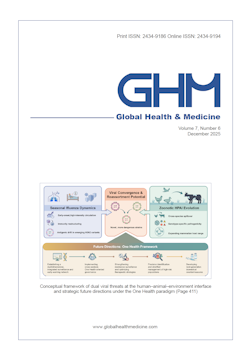Global Health & Medicine 2020;2(2):107-111.
SARS-CoV-2 infection among returnees on charter flights to Japan from Hubei, China: a report from National Center for Global Health and Medicine
Hayakawa K , Kutsuna S, Kawamata T, Sugiki Y, Nonaka C, Tanaka K, Shoji M, Nagai M, Tezuka S, Shinya K, Saito H, Harada T, Moriya N, Tsuboi M, Norizuki M, Sugiura Y, Osanai Y, Sugiyama M, Okuhama J, Kanda K, Wakimoto Y, Ujiie M, Morioka S, Yamamoto K, Kinoshita N, Ishikane M, Saito S, Moriyama Y, Ota M, Nakamura K, Nakamoto T, Ide S, Nomoto H, Akiyama Y, Suzuki T, Miyazato Y, Gu Y, Matsunaga N, Tsuzuki S, Fujitomo Y, Kusama Y, Shichino H, Kaneshige M, Yamanaka J, Saito M, Hojo M, Hashimoto M, Izumi S, Takasaki J, Suzuki M, Sakamoto K, Hiroi Y, Emoto S, Tokuhara M, Kobayashi T, Tomiyama K, Nakamura F, Ohmagari N, Sugiyama H
Due to the significant spread of a new type of coronavirus (SARS-CoV-2) infection (COVID-19) in China, the Chinese government blockaded several cities in Hubei Province. Japanese citizens lost a means of transportation to return back to Japan. The National Center for Global Health and Medicine (NCGM) helped the operation of charter flights for evacuation of Japanese residents from Hubei Province, and this article outlines our experiences. A total of five charter flights were dispatched, and the majority of returnees (793/829 [95.7%]) were handled at NCGM. A large number of personnel from various departments participated in this operation; 107 physicians, 115 nurses, 110 clerical staff, and 45 laboratory technicians in total. Several medical translators were also involved. In this operation, we conducted airborne precautions in addition to contact precautions. Eye shields were also used. The doctors collecting the pharyngeal swab used a coverall to minimize the risk of body surface contamination from secretions and droplets. Enhanced hand hygiene using alcohol hand sanitizer was performed. Forty-eight persons were ultimately hospitalized after the triage at NCGM operation, which was more than the number of persons triaged at the airport (n = 34). Of those hospitalized after NCGM triage, 8.3% (4/48 patients) ultimately tested positive for SARS-CoV-2, significantly higher than the positive rate among subjects not triaged (4/48 [8.3%] vs. 9/745 [1.2%]: p = 0.0057). NCGM participated in a large-scale operation to evacuate Japanese nationals from the COVID-19 epidemic area. We were able to establish a scheme through this experience that can be used in the future.
DOI: 10.35772/ghm.2020.01036







